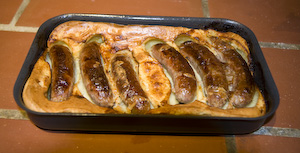Some of the recipes in Hannah Glasse’s The Art of Cookery, made Plain and Easy seem to come from another world. So much has changed in the 260 years since she was writing that the many of the recipes seem bizarre and most of us would have no idea how to combine them to produce a coherent meal. Some recipes use birds or fish that aren’t commonly eaten these days, or use bits of them that we’re not used to eating (there are three different ways to cook a cod’s head, for instance). Some have combinations of sweet and savoury that look strange these days: like sprinkling sugar over your potatoes.
It’s a surprise, in the midst of this alien world, to come across a recipe that is still in common use, pretty much unchanged.
To make Common Saufages.
Take three Pounds of nice Pork, Fat and Lean together, without Skin or Grifles; chop it as fine as poffible, feafon it with a Tea Spoonful of beaten Pepper, and two of Salt, fome Sage fhread fine, about three Tea Spoofuls; mix it well together, have the Guts very nicely cleaned, and fill them, or put them down in a Pot, so roll them of what Size you pleafe, and fry them. Beef makes very good Saufages.
For “fine sausages,” she recommends using only lean pork, and substituting beef suet for the fat (using equal quantities of pork and suet), and adding sweet herbs, nutmeg and lemon zest to the seasoning.
Of course, sausages are much older than the 18th century. They were certainly around in Roman times, though the fact that the latin name for sausages is the origin of the word “botulism” suggests it would have been wise to approach them with some caution.
It’s quite possible that even in Glasse’s day those who were less wealthy than her readers might have added some cereal to the mix. These days, some sausages, like Glasse’s, are made with just meat and seasonings, while others have substantial cereal additions. Walls sausages for instance contain about 65% meat, with water and rusk making up the bulk of the remainder.
I’ve experimented with various formulae, and finally decided that just a little bread improves the sausage texture and helps it to stay juicy when it’s cooked. I use pork shoulder, and try to get a moderately fatty piece. If there isn’t much fat, then I’ll add in some belly pork, or extra back fat (if you’re buying your meat from a butcher, he’ll probably have some he can spare). I also like a pretty traditional seasoning, but there’s plenty of scope for variation: rosemary and thyme; juniper; fennel…
For a couple of pounds of meat, I use:
1 1/2 oz breadcrumbs (about 5% of the weight of the meat)
1 Tbsp Maldon salt (the brand isn’t important, but the big flakes mean you don’t get so much in a tablespoon – if you’re using finely ground salt, use 2 tsp, or 1.5% of the weight of the meat)
Chopped sage – a handful
1/2 Tbsp ground mixed spice (about half black pepper, and the rest a mixture of nutmeg, mace, cinnamon, clove, allspice).
2 yards of hog casings (sheep casings give thinner, chipolata-size sausages)
Mince the meat. I prefer a coarse grind. Mix in the breadcrumbs and seasonings, then put the mixture through the mincer again. My mincer has an attachment for stuffing sausages. Basically, you remove the chopping plates, and add a funnel. Lubricate the outside of the funnel (butter or lard work pretty well). Thread the sausage casings onto the funnel, then feed the mixture through again, this time into the casing. Tie off the ends of the casing and twist the sausages to the length you want.
The sausages will be better if you can leave them for a day or two before cooking them. I put them on a plate in the fridge, covered with kitchen paper.
You could fry them and serve with mash and/or braised sauerkraut; braise them with beef stock, red wine and chestnuts; or combine them with another old English favourite, Yorkshire Pudding, to make Toad in the Hole.

2 comments
Comments feed for this article
November 17, 2008 at 9:49 am
legatushedlius
The problem is with this site is that I keep wanting to invite myself down!
Oh, I have!
See!
November 18, 2008 at 5:03 pm
BabyBro
I would heartily recommend the toad in the hole.
But then I am rather a sausage fiend already!